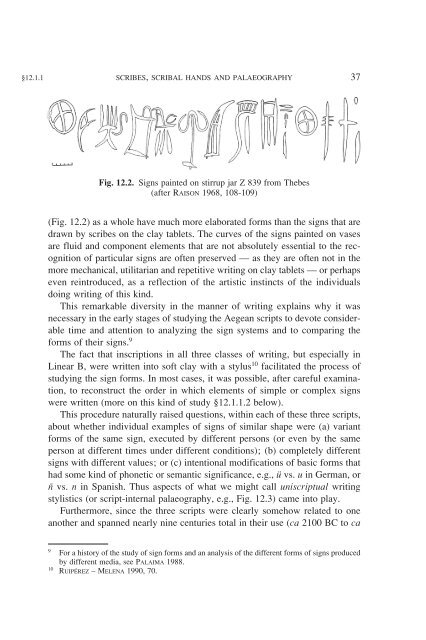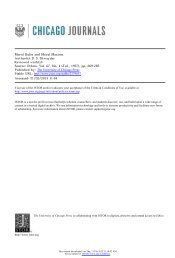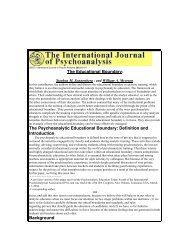A Companion to Linear B - The University of Texas at Austin
A Companion to Linear B - The University of Texas at Austin
A Companion to Linear B - The University of Texas at Austin
You also want an ePaper? Increase the reach of your titles
YUMPU automatically turns print PDFs into web optimized ePapers that Google loves.
§12.1.1 SCRIBES, SCRIBAL HANDS AND PALAEOGRAPHY 37<br />
Fig. 12.2. Signs painted on stirrup jar Z 839 from <strong>The</strong>bes<br />
(after RAISON 1968, 108-109)<br />
(Fig. 12.2) as a whole have much more elabor<strong>at</strong>ed forms than the signs th<strong>at</strong> are<br />
drawn by scribes on the clay tablets. <strong>The</strong> curves <strong>of</strong> the signs painted on vases<br />
are fluid and component elements th<strong>at</strong> are not absolutely essential <strong>to</strong> the recognition<br />
<strong>of</strong> particular signs are <strong>of</strong>ten preserved — as they are <strong>of</strong>ten not in the<br />
more mechanical, utilitarian and repetitive writing on clay tablets — or perhaps<br />
even reintroduced, as a reflection <strong>of</strong> the artistic instincts <strong>of</strong> the individuals<br />
doing writing <strong>of</strong> this kind.<br />
This remarkable diversity in the manner <strong>of</strong> writing explains why it was<br />
necessary in the early stages <strong>of</strong> studying the Aegean scripts <strong>to</strong> devote considerable<br />
time and <strong>at</strong>tention <strong>to</strong> analyzing the sign systems and <strong>to</strong> comparing the<br />
forms <strong>of</strong> their signs. 9<br />
<strong>The</strong> fact th<strong>at</strong> inscriptions in all three classes <strong>of</strong> writing, but especially in<br />
<strong>Linear</strong> B, were written in<strong>to</strong> s<strong>of</strong>t clay with a stylus 10 facilit<strong>at</strong>ed the process <strong>of</strong><br />
studying the sign forms. In most cases, it was possible, after careful examin<strong>at</strong>ion,<br />
<strong>to</strong> reconstruct the order in which elements <strong>of</strong> simple or complex signs<br />
were written (more on this kind <strong>of</strong> study §12.1.1.2 below).<br />
This procedure n<strong>at</strong>urally raised questions, within each <strong>of</strong> these three scripts,<br />
about whether individual examples <strong>of</strong> signs <strong>of</strong> similar shape were (a) variant<br />
forms <strong>of</strong> the same sign, executed by different persons (or even by the same<br />
person <strong>at</strong> different times under different conditions); (b) completely different<br />
signs with different values; or (c) intentional modific<strong>at</strong>ions <strong>of</strong> basic forms th<strong>at</strong><br />
had some kind <strong>of</strong> phonetic or semantic significance, e.g., ü vs. u in German, or<br />
ñ vs. n in Spanish. Thus aspects <strong>of</strong> wh<strong>at</strong> we might call uniscriptual writing<br />
stylistics (or script-internal palaeography, e.g., Fig. 12.3) came in<strong>to</strong> play.<br />
Furthermore, since the three scripts were clearly somehow rel<strong>at</strong>ed <strong>to</strong> one<br />
another and spanned nearly nine centuries <strong>to</strong>tal in their use (ca 2100 BC <strong>to</strong> ca<br />
9 For a his<strong>to</strong>ry <strong>of</strong> the study <strong>of</strong> sign forms and an analysis <strong>of</strong> the different forms <strong>of</strong> signs produced<br />
by different media, see PALAIMA 1988.<br />
10 RUIPÉREZ – MELENA 1990, 70.

















